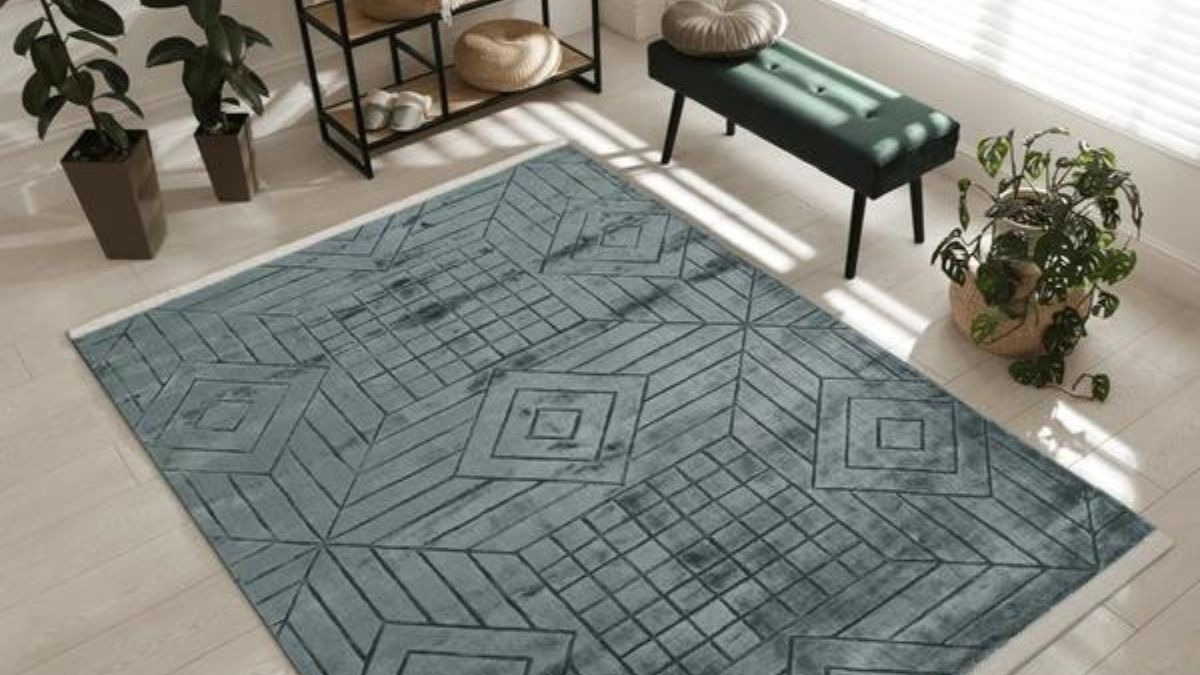HOME IMPROVEMENT
How to Choose the Perfect Neutral Area Rug for Every Room

An area rug may add appeal, warmth, and safety to a living space. Choosing the right area rug completes your living space, makes it look well-proportioned, and complements your existing decor. Most people associate “neutral area rugs” with brown, beige, or warm-coloured rugs. While those are neutral rugs, there are a variety of different options available. These are rugs that are either unsaturated, colourless, or dyed in neutral tones of black, grey, white, and brown. The most common colours are brown, cream, tan and beige. A neutral rug’s understated colours allow it to complement any other pattern or design element in your place without taking centre stage. We will provide you with a guide on how to choose the perfect neutral rugs online for every room.
Tips for Choosing the Perfect Neutral Area Rugs for Every Room
-
Make a Budget
When buying a new rug, always prepare a budget. Rug costs vary greatly, depending on size and material. Rug prices vary greatly, depending on size and material. After you’ve measured your room, you can choose the right rug size. Then, when choosing a material, consider your budget. Hand-woven rugs are more expensive than factory-made ones. Other elements influencing the pricing include patterns, prints, tufting, knotting, and texture such as shaggy or contemporary. Prioritizing your budget and preferences will help you find a rug that fits your space and taste without breaking the bank.
-
Determine the Area
Outline the area that the rug will cover on the floor to get a sense of how much of it will be. You will not want to entirely cover up your beautiful floors. However, a rug should be large enough to serve as a visual anchor in the area and should be positioned beneath your key fabric pieces in the room, whether they be a couch, chairs, or both. When you purchase neutral area rugs, make sure they are the correct sizes by measuring them.
-
Choose the Shape of the Rug
While rectangular or square neutral area rugs are popular in living rooms with seating arrangements, round, oval, or octagonal designs are as attractive. These shapes can offer visual appeal and complement unusual furniture arrangements. For example, if you have a round or oval coffee table, use a rug with a similar shape to highlight it. Round rugs, in particular, are measured in diameter. To determine the appropriate size, measure from the centre of your living room to the outer edges of the seating area. Then, double the length in feet to get the diameter size you require. For example, if the measurement from the centre to the outer edge of your couch is 4 feet, doubling it results in an 8-foot circumference area rug that is appropriate for your room. With this strategy, you can ensure that your rug fits correctly and complements the overall look of your living room.
-
Select a Texture
A rug’s texture can make a space feel more inviting, warm, and minimalist. A shaggy rug, for example, will give the interior a relaxed sense; a jute rug will offer the space character and texture; a wool rug will not only provide texture but also warmth to the area; and a knotted rug will create an aesthetically beautiful impression while adding subtle texture. The texture can enhance the overall atmosphere of the room in a variety of ways. It can provide interest to a room that is otherwise austere, pull it together, and create levels of intrigue. A minimalist space, for example, with a mix of tones and colours, can be complemented by a rug with a corresponding colour palette, but only if its texture adds interest. This will allow it to stand out rather than be overshadowed by the room’s colour palette.
-
Consider the Colors and Patterns
Choosing the perfect area rug can significantly affect the overall mood of your living room. A patterned rug may add color and visual interest to spaces with bland furniture and walls. For practicality and ease of upkeep in areas prone to dirt and spills, select a darker-coloured patterned rug. Alternatively, for eclectic decor schemes, a solid-coloured rug in a neutral tone can bring the space together without overpowering the varied aspects. When selecting an area rug, look for one or two primary colors in your existing decor to guarantee a coherent and visually appealing design. Following these principles will allow you to easily improve the style of your living room while also creating a welcoming and visually appealing setting.
Conclusion
Looking for rugs online? Miss Amara is the ultimate online destination for high-quality rugs in the United States. We have a large collection of traditional rugs, boho rugs, modern rugs, and any rug pattern you can imagine. We offer neutral carpeting to improve the visual attractiveness of your room. Layering neutral area rugs adds texture and definition to your room. Hope our tips were useful for you in deciding how to buy the perfect area rug.

HOME IMPROVEMENT
Transform Your Home with Exterior Painting: A Step-by-Step Guide to Boost Your Curb Appeal

Improve your home’s appearance by giving it a new layer of paint, increasing its attractiveness from the street. Follow these steps: Prepare surfaces by cleaning and repairing; choose high-quality paint suitable for the material; apply primer and multiple coats evenly; and finish with trim and accents. Transform your home’s appearance and make a lasting impression.
Why Exterior Painting Matters
Painting the exterior of your home is not just about enhancing its appearance; it’s also crucial for protecting your home from various elements. A strong coat of exterior paint defends against severe weather elements like rain, wind, and sun. A well-executed paint job can help mitigate the risk of mold and structural damage by sealing gaps and preventing moisture from seeping into the walls. Additionally, a fresh coat of paint can significantly increase the property value, making your home more attractive to potential buyers. You may want to find out more about what goes into a professional exterior painting project.
Choosing the Right Paint
- Weather Resistance: Opt for paints specifically designed to withstand extreme weather conditions. These paints are formulated to resist cracking, peeling, and blistering, ensuring your home remains well-protected for years.
- Color Selection: Choose colors that complement your home’s architectural style and personal taste. Whites, grays, and beiges are neutral hues in style because they are universally appealing and can give the impression that your home is cozier.
- Finish: Decide between different finishes, such as flat, satin, or gloss. Each finish offers a unique look and varying levels of protection. Flat finishes provide a smooth, matte texture but may need to be more durable. Satin finishes give a slight sheen and are easier to clean, while gloss finishes are the most durable but can highlight surface imperfections.
For expert tips on selecting the best paint, consult this guide on exterior paint colors. It provides valuable insights into choosing shades to make your home stand out while staying true to your style.
Preparing Your Home for Painting
Preparation is crucial for a painting project to be successful. Adequate preparation guarantees that the paint will bond effectively and have a longer lifespan. Here’s a checklist to help you get started:
- Clean Surfaces: First, remove all dirt, mildew, and loose paint from the surfaces. A pressure washer or a scrub brush with a light detergent can be used for this. Clean surfaces provide a better canvas for new paint.
- Repair Damage: Inspect your home’s exterior for cracks, holes, or damaged areas. Use a high-quality filler to repair these imperfections. Ensure ample time for the repairs to dry before proceeding to the next step.
- Sanding and Priming: Sand down rough or uneven areas to create a smooth surface. Primers are essential because they improve paint adhesion and give topcoats a uniform foundation. A good primer can also block stains and seal porous surfaces.
Tools and Materials You’ll Need
- High-quality exterior paint: Investing in premium paints will give you better coverage and durability.
- Primer: Essential for ensuring the paint adheres well to the surface.
- Brushes and rollers: Use high-quality tools to apply the paint smoothly.
- Painter’s tape: Helps create clean edges and prevents paint from getting on unwanted areas.
- Drop cloths: Protects your landscaping, decking, and outdoor furniture from paint splatters.
- Ladders or scaffolding: Ensures you can safely reach all areas of your home.
Step-by-Step Painting Process
- Start with the Trim: Paint the trim first. This strategy minimizes the risk of accidentally getting trim paint on the freshly painted walls. Use a brush to paint the edges and detailed areas carefully.
- Main Surfaces: Use rollers to cover large areas quickly. Switch to a brush for precise application on edges and corners. Apply the paint in even strokes, ensuring complete coverage.
- Multiple Coats: Paint a surface with two coats at minimum. Let the initial layer fully dry before applying the second. Multiple coats provide better coverage and durability.
- Final Touches: Once the central painting is done, carefully remove the painter’s tape to avoid peeling off any paint. Touch up any areas that need additional attention for a flawless finish.
Common Mistakes to Avoid
Here are some common pitfalls to watch out for:
- Skipping Preparation: Inadequate surface prep can lead to peeling paint. Properly cleaning, repairing, and priming surfaces is essential for a long-lasting paint job.
- Using Low-Quality Paint: While cheaper paints may save money upfront, they often require more frequent touch-ups and may not provide the same level of protection. Investing in high-quality paint pays off in the long run.
- Ignoring Weather Conditions: The weather can significantly affect the success of your painting project. Paint on a dry, mild day for the best results. Please avoid painting in very high or low temperatures, as these may impact how well the paint dries and sticks.
Maintaining Your New Look
Once your exterior painting project is complete, you’ll want to maintain that fresh look for as long as possible. Here are some tips:
Watch for wear indicators in your house and touch up any areas that need it. Pay special attention to spots exposed to the elements, such as windowsills and door frames. Washing off dirt and grime will also enhance the longevity and appearance of your paint job. Consider applying a clear sealant for added protection.
Conclusion: The Long-Term Benefits
Investing in a high-quality external paint job can protect your home from harm, raise its value, and enhance its curb appeal. It’s one of the most cost-effective ways to beautify and safeguard your home. By following the abovementioned procedures, you can guarantee a painting project that will enhance your home’s appearance while offering long-lasting weather protection.
HOME IMPROVEMENT
With Planning and Some Simple Hacks, It’s Possible to Survive a Kitchen Remodel

Remodeling the kitchen is exceptionally difficult as it requires paying close attention to details and being extra thorough in managing tasks, which often means completion time is longer. The bigger the job, the more critical it is to find a great team of professionals. Surviving a kitchen renovation can be tricky because remodeling creates a mess, even if the end result is well worth it, and no matter how hard you try to stay organized, more stuff keeps piling.
Contractors and professionals with years of experience, not to mention people who’ve lived through the experience, agree that it’s best to beat a hasty retreat and stay somewhere else while it might seem inconvenient or unnecessary. The crew can work faster because it has a few more hours a day. If moving out isn’t an option, you’ll have to make sacrifices if you want to survive the weeks to months of construction ahead. Read on for essential tips to help you navigate various obstacles in a kitchen renovation scenario.
Be Ready for What’s About to Happen
While you’d say you’re excited, you’re also scared, imagining the best and worst that can happen, so this would be an excellent time to go and do the work to prepare. You must be mentally prepared to make an overwhelming number of big decisions, whether selecting the proper layout for your space or judging if your kitchen is suitable for upgrading with replacement kitchen doors to stay on budget (and on schedule). It can leave you feeling incredibly anxious and stressed, and the emotional upheaval comes with having your home upended for a very long time.
The decisions can be enough to throw your brain into a meltdown. You can’t make breakfast to jump-start your day, or you find yourself washing and rinsing the dishes in the bathtub, which would make you appear somewhat behind the times. It’s better to let go rather than hold on. Take advantage of this opportunity to practice yoga or learn how to meditate because remodeling the kitchen is a complicated process with many moving parts, from scheduling subcontractors to coordinating deliveries for the new hardware you just ordered.
Set Up a Temporary Space for Cooking (Away from The Construction)
You and your loved ones eat all your meals at the kitchen table, but it’ll be unavailable during remodeling, so move the refrigerator to another room, along with mugs, plates, and cutlery. It’ll take some time to get used to living in a construction zone, but at least you can avoid food delivery, which can be expensive and detrimental to your well-being. If you find it hard to scoot the fridge, get a small college fridge for the essentials. In the summer, you can use the patio for cooking, but otherwise, the temporary kitchen can be the dining room, utility room, or anything that makes sense.
Invest In Paper Plates and Disposable Utensils
Maybe you find it unacceptable to throw the dishes into the bathtub to mass wash everything. If that’s the case, use paper plates and disposable utensils because they take less time and effort to clean up and are safe to use when the kids are around. Pick compostable items that don’t have a plastic coating to leave behind no detrimental impact on the environment and create a better future for your children. Keep the lid of the trash bin firmly closed to prevent nasty odors and pests from escaping.
Keep A Donation Bin Nearby While Packing the Kitchen
Unload everything in your kitchen and pack it away, having a donation bin nearby. Donating your unneeded possessions keeps functional and often desirable items out of the landfill, and you get to help others by getting rid of your trash. Ask yourself what’s worth packing, storing, unpacking, and so on. Examples of construction waste that can be donated are cabinets, working appliances, tiles and wood flooring, and door handles. You can become part of a process that helps families create independence, stability, and a better future.
Seal Up Other Areas of The Home That’ll Be Affected When Remodeling
If there are rooms nearby, they’ll be affected by the excess dust and building debris, so protect your home and make cleanup easier by creating a barrier between the kitchen and the rest of the house. Be prepared to improvise and use what you’ve got at hand. Protect the floor that leads to the kitchen, but don’t forget about the less travelled paths, like the one that leads to the bathroom or the room where the electrical panel is located. Protect the countertops from nicks, scratches, and cracks by covering them in cardboard.
Be Strategic About Where You Spend and Save
Contractors have been in short supply, and because of this, they have more power. If they leave projects half-accomplished or don’t do a good job, opportunities are always there, and new clients line up at their doors. Unless you make a plan, legal protection is close to non-existent. Try your best to negotiate the deposit down and know for sure what it’ll be used for – you can request monthly accounting with detailed items and progress lien waivers. Sometimes, contractors use the capital to finish the job before yours.
While the options for hardware finishes and cabinet styles are seemingly infinite, your budget isn’t, so you’ll want to make all your choices really count, not just for your lifestyle but because they affect the resale value of your property. Really know yourself and what you’re happy to compromise on. You can add two ovens so you can cook different things at the same time and at different temperatures, but that means you can’t splash out on a porcelain tiled floor that comes with a hefty price tag.
Wrapping It Up
Irrespective of how challenging it might seem, surviving a kitchen remodel isn’t as hard as it looks, so be patient because even if it takes a long time, the result is worth it. When the mess and stress get to you, make a list of the things you’re grateful for to remind yourself it’s not so bad.
-

 ENTERTAINMENT1 week ago
ENTERTAINMENT1 week agoInside a Coomer Party: A Closer Look at this Growing Trend
-

 HOME2 weeks ago
HOME2 weeks agoExploring the Mystical World of Aoomaal: A Comprehensive Guide
-

 CRYPTO3 months ago
CRYPTO3 months agoUSDTCCK: The Rising Star in the World of Cryptocurrency
-

 HOME2 months ago
HOME2 months agoSandra Orlow: The Teen Model Who Captivated the Internet
-

 HEALTH3 months ago
HEALTH3 months agoThe Health Benefits of Avple: Why You Should Add it to Your Diet
-

 HEALTH2 weeks ago
HEALTH2 weeks agoKecveto: The Ultimate Superfood for Boosting Energy and Vitality
-

 BUSINESS1 month ago
BUSINESS1 month agoImportance of PCI DSS Compliance for Merchant Service Providers
-

 HEALTH2 months ago
HEALTH2 months agoIntegrating Semaglutide into Your Weight Loss Plan: A Practical Guide